A multifunctional injectable ε-poly-L-lysine-loaded sodium-alginate/gelatin hydrogel promotes the healing of infected wounds by regulating macrophage polarization and the skin microbiota
IF 9.6
1区 医学
Q1 DERMATOLOGY
引用次数: 0
Abstract
Background Infected wounds caused by bacteria such as Escherichia coli (E. coli) and Staphylococcus aureus (S. aureus) pose significant challenges during the healing process. Hydrogels have emerged as promising materials for the treatment of such infections, as they have the potential to deliver therapeutic agents while supporting tissue repair. Methods In this study, we developed ε-PLL@SA/Gel (PSG) hydrogels by embedding different concentrations of ε-poly-L-lysine (ε-PLL) into sodium alginate (SA)/gelatin (Gel) hydrogels using calcium chloride as a crosslinking agent. The mechanical properties, biocompatibility, antibacterial activity, and wound healing efficacy of the hydrogels were evaluated in vitro and in vivo in mouse models of infected wounds. Results PSG hydrogels exhibited excellent mechanical strength, injectability, and self-adhesive properties. In vitro, hydrogel treatment resulted in high cell viability and promoted human skin fibroblast proliferation. PSG15 exhibited the highest antibacterial activity and inhibited E. coli and S. aureus by 89.53% and 92.21%, respectively. In vivo, PSG15 significantly accelerated wound healing, enhanced angiogenesis, and regulated macrophage polarization by increasing CD206 expression and decreasing CD80 expression. Additionally, PSG15 modulated the skin microbiota, reduced pathogenic bacterial abundance and maintained microbiota diversity. Conclusion The PSG15 hydrogel is a promising candidate for the treatment of infected wounds because it inhibits bacterial growth, promotes tissue repair, and modulates the wound microbiota.负载ε-聚l -赖氨酸的海藻酸钠/明胶凝胶通过调节巨噬细胞极化和皮肤微生物群促进感染伤口愈合
背景大肠杆菌(E. coli)和金黄色葡萄球菌(S. aureus)等细菌引起的伤口感染在愈合过程中构成了重大挑战。水凝胶已经成为治疗这种感染的有前途的材料,因为它们有可能在支持组织修复的同时提供治疗药物。方法以氯化钙为交联剂,将不同浓度的ε-聚l -赖氨酸(ε- pll)包埋在海藻酸钠(SA)/明胶(Gel)水凝胶中,制备ε-PLL@SA/凝胶(PSG)水凝胶。在小鼠感染创面模型中对水凝胶的力学性能、生物相容性、抗菌活性和创面愈合效果进行了体外和体内评价。结果PSG水凝胶具有优异的机械强度、注射性和自粘性。在体外,水凝胶处理可提高细胞活力,促进人皮肤成纤维细胞增殖。PSG15的抑菌活性最高,对大肠杆菌和金黄色葡萄球菌的抑制率分别为89.53%和92.21%。在体内,PSG15通过增加CD206表达和降低CD80表达,显著加速伤口愈合,促进血管生成,调节巨噬细胞极化。此外,PSG15调节皮肤微生物群,降低致病菌丰度,维持微生物群多样性。结论PSG15水凝胶具有抑制细菌生长、促进组织修复和调节创面微生物群的作用,是治疗感染创面的理想材料。
本文章由计算机程序翻译,如有差异,请以英文原文为准。
求助全文
约1分钟内获得全文
求助全文
来源期刊

Burns & Trauma
医学-皮肤病学
CiteScore
8.40
自引率
9.40%
发文量
186
审稿时长
6 weeks
期刊介绍:
The first open access journal in the field of burns and trauma injury in the Asia-Pacific region, Burns & Trauma publishes the latest developments in basic, clinical and translational research in the field. With a special focus on prevention, clinical treatment and basic research, the journal welcomes submissions in various aspects of biomaterials, tissue engineering, stem cells, critical care, immunobiology, skin transplantation, and the prevention and regeneration of burns and trauma injuries. With an expert Editorial Board and a team of dedicated scientific editors, the journal enjoys a large readership and is supported by Southwest Hospital, which covers authors'' article processing charges.
 求助内容:
求助内容: 应助结果提醒方式:
应助结果提醒方式:


